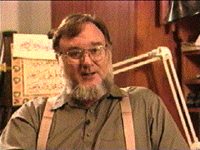- Mohamed Zakariya
-
Mohamed Zakariya (Arabic: محمد زكريا), born 1942 in Ventura, California, is an American master of Arabic calligraphy. An American Muslim, he is perhaps best known for his work on the popular Eid U.S. postage stamp. Raised in California, Zakariya trained as an aerospace engineer as a young man. However, a trip to Morocco would change his life and future career path. He was fascinated by the culture, religion, and language that he encountered in Morocco. It was this experience that led him to study and eventually convert to Islam. However, his love for Arabic calligraphy began even earlier, when, as a boy in Santa Monica, he first saw a work of Arabic calligraphy hanging on the wall of an Armenian carpet shop.
Many years later, Zakariya traveled the Muslim world, making stops in Egypt, Algeria, and Turkey, studying the art of Islamic calligraphy. Back in the U.S., Zakariya was advised by the curator of Islamic Art at the Freer Gallery in Washington D.C. to return to Turkey and train under one of the learned masters there. In 1984, he was offered the chance to study under the world-renowned master calligrapher Hasan Celebi in Istanbul, an offer which he eagerly accepted. In 1988, Celebi declared Zakariya to be a master calligrapher and awarded him the distinguished advanced diploma, the "icazet" in thuluth and naskh scripts in a ceremony in Istanbul. In 1997, he received the "icazet" in taliq style from another Turkish master calligrapher Dr. Ali Alparslan.
Today, Zakariya continues his art in the U.S. where he trains his own students and regularly holds exhibitions and workshops across the country. More recently, Zakariya and his works were featured in the award-winning, PBS-broadcast documentary "Muhammad: Legacy of a Prophet" (2002), produced by Unity Productions Foundation.
Articles published by Mohamed Zakariya
- "Comment: Preserving Heritage", Islamica Winter 2005-6.
- "The Hilye of the Prophet", Seasons, Autumn/Winter 2003-4.
- "Know your Mushaf", The American Muslim, Fall/Winter 1994
External links
- Mohamed Zakariya's homepage
- Sacred Space: The Mosque of the Two Pillars
- Mohamed Zakariya the Teacher
Sources
- "The Soul Searcher", Psychology Today, May/June 2004.
- "The World of Mohamed Zakariya", Saudi Aramco, January/February 1992.
Categories:- 1942 births
- Living people
- American artists
- American calligraphers
- American Muslims
- Converts to Islam
- Calligraphers of Arabic script
Wikimedia Foundation. 2010.

